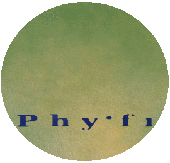
The philosophy behind it is that it should ..
I hope you find it useful. Please send me an email if you have any
comments or suggestions, e.g. if you would like another format to be
included in the download options list. Below are some details about
how the figure is drawn.
The figure is scaled to "fill" the width and height set by the
user. By default, the height is calculated from the number of leaves.
In the Newick format, branches may or may not be labeled with a
length. In the figure produced by Phy·fi, branches are drawn such
that their lengths are as determined in the input string, but the
figure is scaled to match the width setting. If some but not
all branches are labeled in the input string, unlabeled branches are
given a default length and drawn as dashed lines in the figure to
discrimate them from labeled branches whose length can be "visually
trusted". The default length is calculated as the average over the
lengths of all labeled branches. If no branches have labels in the
input string, all branches in the figure are assigned the same length
as appropriate.
All branch labels are reformatted such that they have the same number
of digits after the comma/dot (in case they have one) for easy
comparison. Each is written over its corresponding branch starting at
a point which is 1/6 of its length from its left end.
If the user chooses so, a rule is included in the figure. The rule can
be combined with the branch labels, and it can be used as a
replacement to increase readability. The length of the rule is found
through an intricate algorithm such that it ends up having a length
which is approximately 1/7 of the width of the tree, and such that its
denomination is a "relevant" number with one significant figure.
Phy·fi is an online tool which can draw phylogenies and other
trees in the Newick
format.
You supply an input Newick string and draw the tree. Then, if the
image looks less than perfect, you can choose another image size to
scale the image, toggle
the branch length labels on/off or modify the angle with which they're
written, choose new colors, collapse an irrelevant subtree by clicking its root, and click redraw to see the effect
immediately. Once you're happy with the result, you can download the
image in the format of your choice.
The program parses the input string and creates a tree data
structure. Each leaf, and each internal node with a given label, is
assigned a unique height (y-coordinate) in the image. This means that
as long as the image is made high enough (through the height
parameter), no labels will overlap.